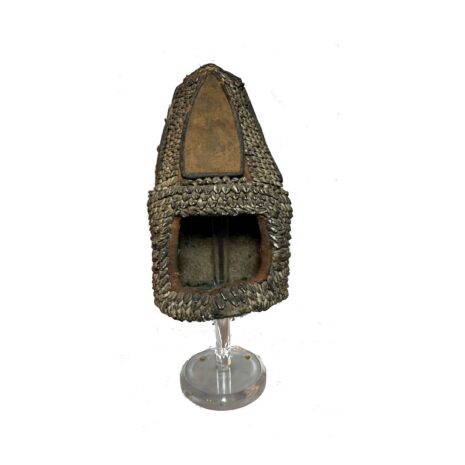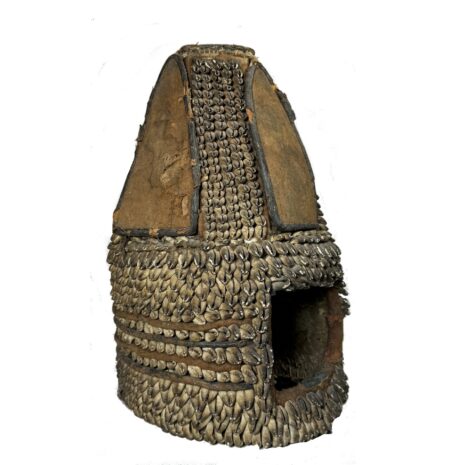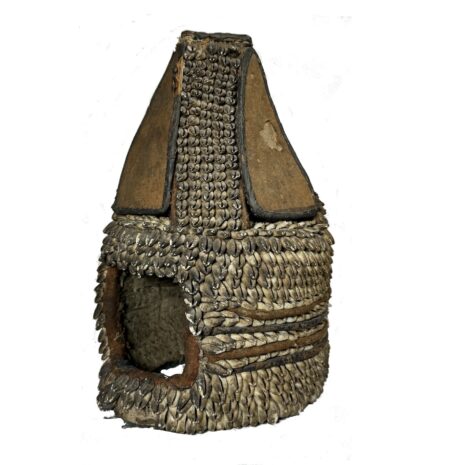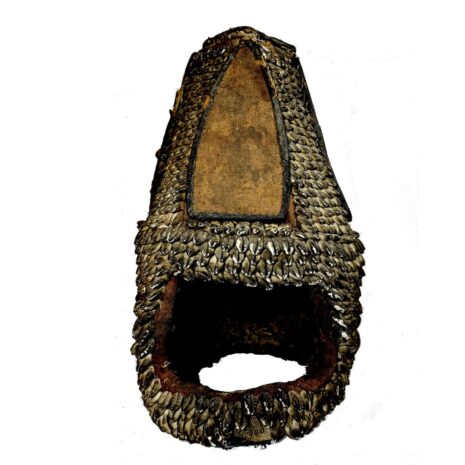Vintage Yoruba Cowrie Shell Head Shrine, Africa, Nigeria (1657BSK)
$785.00
H: 15″ W: 9″ D: 9″ | CALL 213-568-3030 OR EMAIL [email protected] FOR SHIPPING COST
Vintage “crowns” called an ile ori the “house of the head,” were cowrie shell shrine made to show gratitude for and recognition of the power of the head and manifest Yoruba ideas of individuality and authority. Not meant to be worn they are often placed on altars for prayer and divination and can be a symbol of a Yoruba deity. This headdress with an impressive design was included in the San Francisco International Airport, “Crowning Achievements” exhibition in April-August, 1994. It comes with a Lucite stand.
Description
The Yoruba in Nigeria believe in a “cult of the head” in which the head is considered a person’s soul and essence and where good judgment, spiritual intuition and destiny are contained. Not simply a head, ori is a Yoruba metaphysical concept referring to human consciousness, mental clarity and ethical worth. The ile ori is the “house of the head,” an iconic cowrie shell shrine made to show gratitude for and recognition of the power of the head. This concept is central to Orisha (Orisa), the word used for both Yoruba deities and also their religion. Most Africans sew cowrie shells on their textiles as they are a sign of wealth and status. Cowrie crown-like shrines like this are often placed on altars for prayer and divination and can also be a symbol of a Yoruba deity. Cowries are also considered symbols of fertility, birth and wealth and an important in African tribal art. Used for centuries by Africans as currency (shell money), early colonialists imported them to use in the slave trade. Resembling the shape of female organs, they have also been long used on African altars with prayers for births, fertility and sexuality and represent protection by goddesses. Their use in divination, originated by the Yoruba, is among the oldest spiritual practices used to affect the guidance of deities, ancestors and spirits. They are also used to send symbolic messages (aroko), prepare medicinal herbs and aesthetically decorate jewelry and other objects.Never meant to be worn, this head shrine is round, divided into sections with four upward pointed curving triangular panels set in a sea of arranged cowries. The flat-topped symbolic crown is made with a wide rectangular cutout for viewing. As it is handmade, the size, placement and tones of the cowries may vary, but the design is very impressive. The headdress is in good condition with a dark patina showing age and use, some leather bindings lifting, minor insect damage to the fabric, scrapes on the leather and some missing cowry shells. From October 29, 2023–June 2, 2024 the Fowler Museum presented The House Was Too Small: Yoruba Sacred Arts from Africa and Beyond which featured several cowry shell head shrines. This pieces was included in the San Francisco International Airport, “Crowning Achievements” exhibition in April-August, 1994.
Sources
Beverly Chico, Hats and Headwear Around the World: A Cultural Encyclopedia, Santa Barbara, ABC-CLIO, LLC, 2013, p. 249-251
James, B. Odunbaku, Ph.D., “Importance of Cowrie Shells in Pre-Colonial Yoruba land South-Western Nigeria: Orile-Keesai as a Case Study,” in, International Journal of Humanities and Social Science, Vol. 2, No. 18, October 2012, p. 234-241.
Additional information
| Place of Origin | Africa |
|---|---|
| Period | Antique/Vintage (1910-1980) |
| Date | 20th Century |
| Materials and Technique | Cloth |
| Dimensions (inches) | Ht: 15” W: 9” D: 9” On Stand: 20” |
| Dimensions (metric) | Ht: 38.1 cm W: 22.86cm D: 22.86cm On Stand: H: 50.8cm |
| Weight | 6 lbs 10 oz |
| Condition | Very good, patina and wear consistent with age and use |
| Item Number | 1657BSK |
| Width | 6” to 11.9” |
| Shipping Box Size | Oversized. Call 213-568-3030 or email [email protected] for shipping. |










